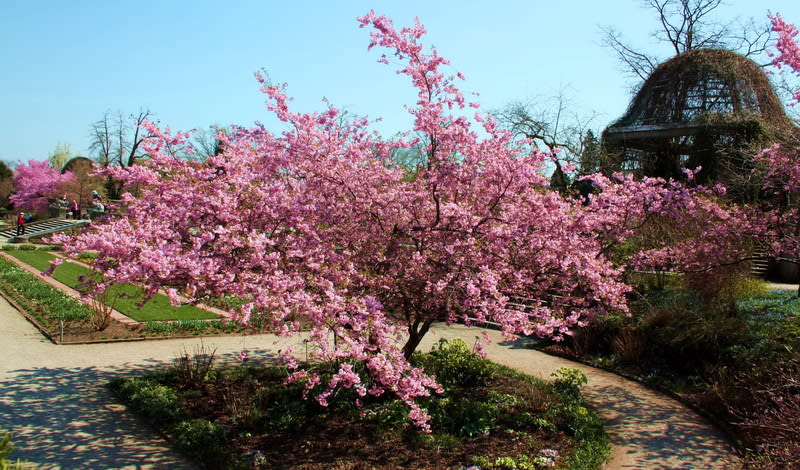Sargent's Cherry, North Japanese Hill Cherry, Japanese Flowering Cherry
Prunus sargentii

🌿 Morphology
🌞 Growing conditions
🌍 Origin and family
🌾 Uses
Warning: Despite the care taken in writing this sheet, it is essential to cross-reference sources before using or consuming any plant. When in doubt, consult a qualified professional
Permaculture uses
Sargent's Cherry is primarily an ornamental tree valued for its beautiful spring flowers and vibrant autumn foliage. The cherries are small and tart, making them less desirable for direct consumption, but can be used in jams, jellies, and preserves. It attracts pollinators like bees and butterflies, benefiting the garden ecosystem. Its dense canopy provides shade. It's not typically used medicinally. Selected cultivars like 'Accolade' and 'Columnaris' offer variations in size and bloom characteristics.
Permapeople description
Prunus sargentii, also known as North Japanese hill cherry or Sargent's cherry, is a species of cherry tree. It is a popular ornamental tree known for its abundant pink blossoms in spring and its attractive red foliage in autumn.
Botanical description
Prunus sargentii, or Sargent's Cherry, is a deciduous tree reaching heights of 20-40 feet with a spreading, rounded crown. The bark is smooth, reddish-brown, and marked with prominent lenticels. The leaves are alternate, simple, ovate to elliptic, 2-5 inches long, and serrated with sharply pointed teeth. They emerge bronze-red in spring, mature to dark green in summer, and turn brilliant shades of orange, red, and purple in the fall. The flowers are single, deep pink, about 1 inch in diameter, and borne in clusters of 2-4. The fruit is a small, dark red drupe, about 1/4 inch in diameter. It is native to Japan, Korea, and Russia.
Companion planting
Sargent's Cherry generally benefits from being planted in areas with good air circulation to prevent fungal diseases. Avoid planting near walnut trees (Juglans) which produce juglone, a chemical that can inhibit growth. It pairs well with other spring-blooming trees and shrubs, as well as groundcovers that appreciate partial shade. Companion plants that attract pollinators, such as lavender or salvia, can further enhance its aesthetic and ecological value.
Propagation methods
Propagation of Prunus sargentii can be achieved through several methods. Seed propagation is possible, but requires stratification to break dormancy. Softwood cuttings taken in late spring or early summer can be rooted under mist. Budding or grafting onto Prunus avium rootstock is a common method for propagating desirable cultivars.
History and traditions
Prunus sargentii is native to Japan, Korea, and Russia, where it has been cultivated for centuries for its ornamental value. It was introduced to the West in the early 20th century and has since become a popular landscape tree. In Japanese culture, cherry blossoms (sakura) are highly symbolic, representing the transience of life and the beauty of nature. Although not as extensively used in traditional medicine as some other Prunus species, the bark and leaves have been used historically in some cultures for their astringent properties.
Usage calendar
Flowering occurs in April-May. Leaf color change is from October-November. Planting is best done in spring or fall. Pruning should be done in late winter to early spring before new growth begins to remove dead or damaged branches and shape the tree.
